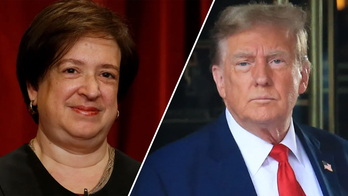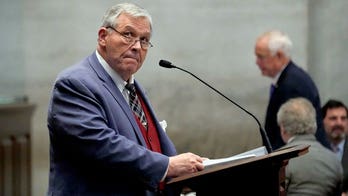The U.S. Constitution is clear as to which branch of government should wield the power of the purse.
But the Obama Administration's decision to purchase a dormant prison in Thomson, IL may challenge that assertion.
President Obama ordered the Justice Department to buy the 15 building facility from the state of Illinois for $165 million. Many Republicans on Capitol Hill immediately crowed that the White House planned to buy the Illinois lockup in an effort to close the prison used to hold terrorism detainees housed at Guantanamo Bay, Cuba. In 2009, the White House plotted to obtain the Illinois facility and transfer Gitmo prisoners there. However, that plan met fierce opposition from Congress.
But what's not met such fierce opposition from Congress is a trend by lawmakers to cede legislative power to the executive branch. And a debate over who controls the federal purse strings unfolded this week amid the debate about the Thomson Correctional Center.
Article I, Section 9 of the Constitution declares that "No Money shall be drawn from the Treasury, but in Consequence of Appropriations made by Law."
Congress writes those laws, meaning House and Senate members have the ultimate authority over spending the government's money. "Appropriations" refers to how the legislative branch decides to go about it, dictating specific dollar figures for departments and programs.
And then there is the practice of earmarking.
Few Congressional customs scored such negative press in recent years as earmarks. There was the "Bridge to Nowhere," a dubious $200 million earmark to help construct a bridge between Ketchikan, AK and Gravina Island. Lawmakers from the Lower 48 howled that Gravina Island only has 50 inhabitants. The sheer volume of earmarks ballooned from several dozen annually 30 years ago to 35,000 earmark requests just a few years ago. The scandal involving superlobbyist Jack Abramoff forced lawmakers to begin evaluating the value and perception of earmarks.
In 2007, Congressional Democrats started reforming the earmark process. They required lawmakers to disclose and justify all earmarks. But House Republicans took things a step further in January, 2008. Under pressure from fiscal conservatives, then-House Minority Leader John Boehner (R-OH) and Minority Whip Roy Blunt (R-MO) proposed an earmark moratorium. By one-upping the Democrats, it was an effort to dare their adversaries into forgoing earmarks. Plus, the GOP could then claim the mantle of earmark reform - even if many of their own members were unapologetic masters of the practice.
"Until a complete earmark moratorium is in place and a bipartisan panel is formed to identify ways to fix Washington's wasteful pork-barrel spending habits, House Republicans will proceed with the adoption of a series of earmark reform standards that we will insist that all House Republican members honor," wrote Boehner and Blunt.
But it took Democrats and President Obama a while to meet the GOP position on an outright earmark ban.
"Done right, earmarks have given legislators the opportunity to direct federal money to worthy projects that benefit people in their districts. And that's why I've opposed their outright elimination," said Mr. Obama in March, 2009.
However, it was clear the president's position was evolving by November, 2010.
"I've called for new limitations on earmarks," said President Obama during his weekly media address.
But the midterm election results may have thoroughly chastened the president on earmarks. His viewpoint fully ripened by the time he gave his State of the Union speech in January, 2011.
"If a bill comes to my desk with earmarks inside, I will veto it," Mr. Obama said.
Meantime, Republicans and Democrats in both the House and Senate embraced the no earmark mantra.
But what's the definition of an earmark?
The non-partisan Congressional Research Service often defines earmarks as "provisions associated with legislation (appropriations or general legislation) that specify certain Congressional spending priorities or in revenue bills that apply to a very limited number of individuals or entities."
The House Republican Conference considers an earmark to be "a provision or report language included primarily at the request of a Member, Delegate, Resident Commissioner or Senator providing, authorizing or recommending a specific amount of discretionary budget authority, credit authority or other spending authority for a contract, loan, loan guarantee, grant, loan authority or other expenditure with or to an entity, or targeted to a specific State, locality or Congressional district, other than through a statutory or administrative formula driven or competitive award process."
By using that definition, an earmark is a Congressional directive from a particular lawmaker assigning the government to spend a certain amount of money on a given project at a specific location.
This is where the conflict over the federal government's purchase of the Illinois prison fuses with the Constitutionally mandated powers of the purse.
"The purchase also violates the Obama administration's own policy against funding earmark requests," said Rep. Frank Wolf (R-VA), who chairs the appropriations subcommittee which handles prison funding. "If you have an earmark ban, I think the American people expect you to live up to it."
But is it an earmark?
Take a look at the Department of Justice website. It includes an entire section about "Congressional communications recommending that funds be committed, obligated, or expended for an earmark." Immediately below that sentence is a letter penned by Senate Majority Whip Dick Durbin (D-IL) to Attorney General Eric Holder and Deputy Attorney General James Cole in July of this year. Durbin's missive asks for a "new reprogramming request to Congress for the acquisition and activation of the Thomson Correction Center in Carroll County, Illinois, for use exclusively as a Bureau of Prisons maximum security facility. As you know, in May 2011, the Department and the State of Illinois agreed on a purchase price of $165 million."
Later in the letter, Durbin tells the Department of Justice that "the only hold up is the signature of Congressman Wolf on a standard reprogramming request." Wolf of course expresses concern that Thomson could be used to house detainees now at Guantanamo Bay. A new law just signed by the president prohibits any such transfer of terror prisoners to the U.S. A Pentagon source tells FOX that "the contract for Thomson no longer has anything to do with detainees. That book closed long ago." The source adds that "the prerequisite for the sale was that the feds would never agree to use it for detainees."
So, the Justice Department even describes Durbin's letter under a section which explicitly refers to earmarks. And Durbin makes the request for the money to the Justice Department. But is that an earmark?
This is where it gets murky. The request to purchase the prison was made in 2010. Not by Durbin. But by President Obama himself in his Fiscal Year 2011 budget request. In the request, the Obama Administration says "this facility will house high security federal inmates and provide much needed bed space at this security level." It goes on to say that "crowding at high security facilities is of great concern to the BOP (Bureau of Prisons...This request will add high security bed space to house persons prosecuted and sentenced under Federal law."
Republicans argue that the Durbin's July letter is the official request for funds since the Obama Administration didn't ask for devoted money to fund the Thomson prison purchase in FY '12. Plus, the GOP points out that the president actually proposed cutting money for prison acquisition in his FY '13 budget.
A Congressional Democratic source says the administration did not ask for the money because it was assumed Congress would fund the prison acquisition in its FY '11 bills. Democrats also contend that the president's move is not an earmark because it never went through the legislative process. Plus, Congressional Democrats say it wasn't Durbin who asked for the Thomson money. It was Mr. Obama himself. Therefore, that doesn't meet the House GOP Conference's definition of an earmark. After all, House Republicans say an earmark must be "primarily at the request of a Member, Delegate, Resident Commissioner or Senator." Democrats say in this case, the president is the "primary" individual making the request.
And there's the rub.
Congress gave up its power to "earmark" and directly control some of the purse strings long ago. But the executive branch retains the authority to "earmark" if it wants, by "reprogramming funds." After all, the White House says all the Justice Department has to do is formally notify Frank Wolf and other lawmakers how it intends to spend the money.
"The president had to intervene and do this directly," said Durbin, though noting this was a "rare" move.
So is it an earmark or not? Democrats say no. Republicans argue yes.
A few years ago, some questions arose about a provision for hospitals which wound up in an omnibus spending bill. Then-Rep. Neil Abercrombie (D-HI) is now the governor of the Aloha State and supported the language because it helped hospitals back home. Questions lingered whether it was Abercrombie or one of his Hawaii colleagues who tucked the hospital language into the bill.
"Of course someone inserted it," scoffed Abercrombie. "This is legislation, not theology."
And perhaps theology may be the only course to find agreement between Democrats and Republicans as to whether the Thomson prison constitutes an earmark.
- Fox's Justin Fishel contributed to this report.




